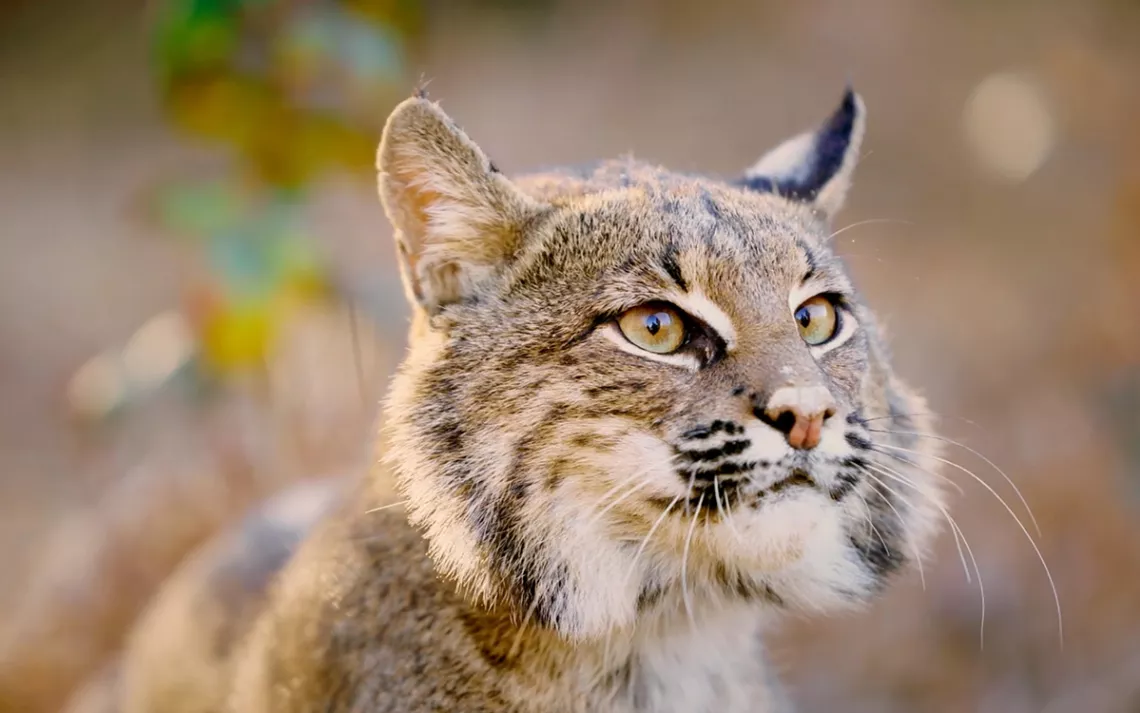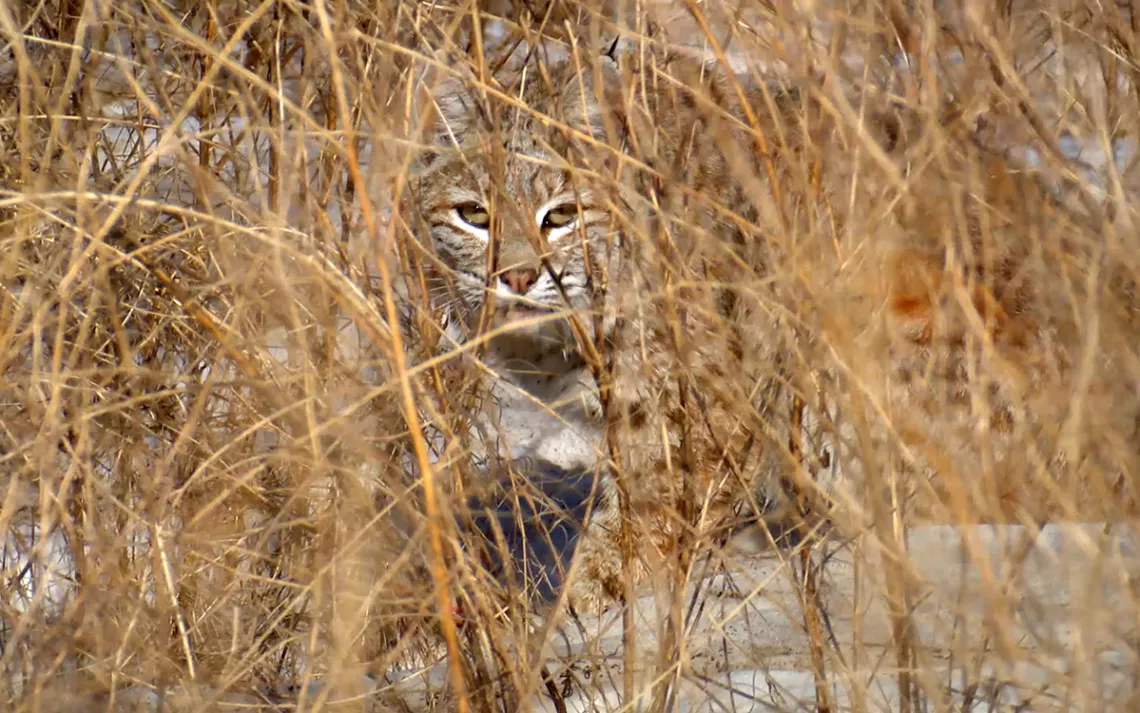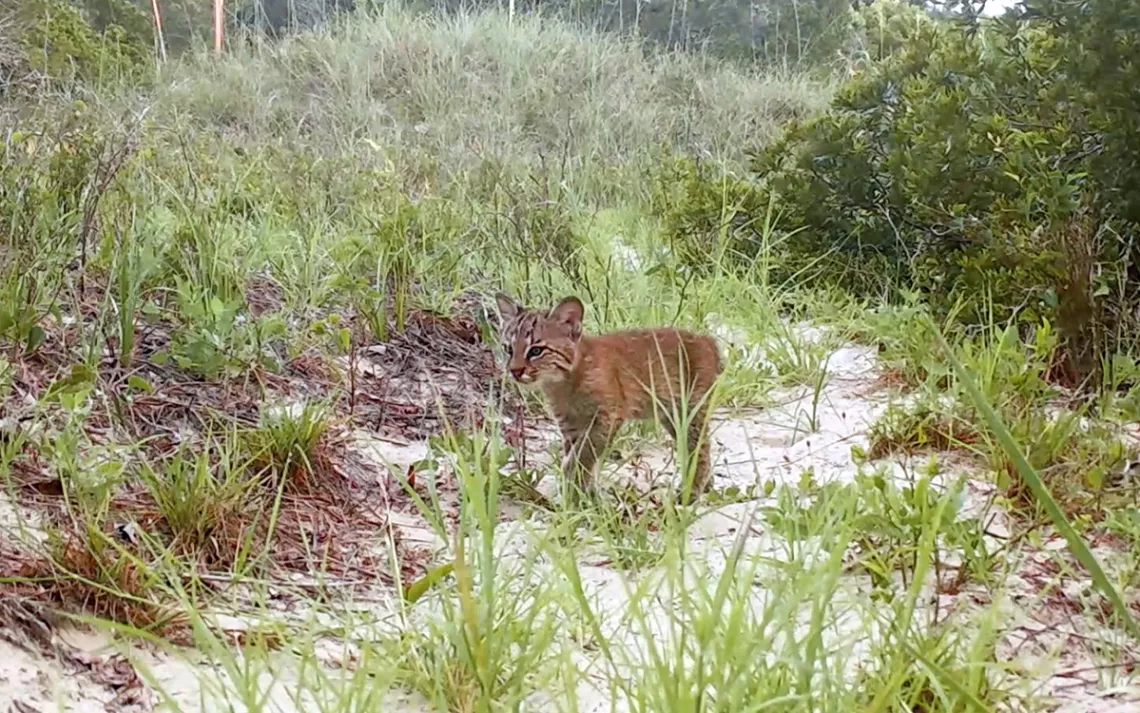The Grassroots Effort to Save Kiawah Island’s Bobcats
Native bobcats were in crisis—until residents volunteered to give up pesticides

Photos courtesy of Kiawah Conservancy
South Carolina’s Kiawah Island is a 15-square-mile barrier island roughly 20 miles from Charleston, filled with maritime forests, wax myrtle thickets, and marshy areas that are a great place to live, if you’re a bobcat. For years, the island’s cat population hovered around 35. That doesn’t sound like much, but it translated to one of the densest and healthiest bobcat populations in the country, with more than double the cats-per-square-mile found in mainland South Carolina. Instead of skirting development like bobcats elsewhere in the country, Kiawah’s bobcats coexisted among neighborhoods, sometimes showing up on a sunny porch or lounging in a trail-side oak tree.
In 2018, however, bobcat numbers on Kiawah Island began a sharp decline. By 2019, the annual survival rate was 33 percent. By the next year, when it dipped below 25 percent, wildlife biologists estimated there were fewer than 10 bobcats left on the island.
“Our first indication that we had a real problem was in August 2019, when we picked up a collared bobcat that had died,” said Jim Jordan, Kiawah’s wildlife biologist. The town sent the bobcat to the Southeastern Cooperative Wildlife Disease Study at the University of Georgia for a necropsy. “They determined the animal had bled to death and they directly attributed this to the second-generation anticoagulant [rodenticides] (SGARs),” Jordan said.
The following year, in May 2020, an adult male bobcat was found dead. In June, a female bobcat bled to death while giving birth to four kittens when she was unable to clot. The lab attributed both deaths to SGARs, found in products designed to kill rats and mice, with brand names like Hot Shot, Generation, Talon, and Havoc.
SGARs, which were created in the 1970s, enter the food chain at the bottom, when rodents eat poisoned bait. While their toxicity is much higher than earlier versions, SGARs work slowly, taking up to seven days to kill rodents. The poison makes them slow and lethargic in that time, an easy catch for predators, like bobcats, for whom small mammals are a favorite food.

The town took swift action and sought to ban SGARs, but quickly learned they didn’t have the jurisdiction to do so. Pesticides and rodenticides are regulated at the federal level by the Environmental Protection Agency, but states have their own rules on the books. In general, state laws must mirror federal laws, in keeping with the Federal Insecticide, Fungicide, and Rodenticide Act. Like 42 other US states, South Carolina has laws in place preventing local regulation of the chemicals. “Our state law has preemptive language that says that only Clemson University’s Department of Pesticide Regulation can regulate pesticides in South Carolina, and that’s long-standing,” explained Steve Cole, the university’s director of regulatory services, adding that this serves to ensure consistency.
There is some flexibility at the state level when it comes to restrictions and product labeling if there’s a proven imminent risk to the environment, an endangered species, or human health.
In July 2020, the Kiawah Town Council requested a one-year ban on SGARs by the Department of Pesticide Regulation (DPR), and South Carolina Senator Chip Campsen III wrote the department a letter in support of the ban.
Kiawah had a strong case. The town brought data attributing at least seven bobcat deaths to SGARs in 2019 and 2020. But bobcats are not endangered and SGARs—like the more than 15,000 registered pesticides in the state of South Carolina—are legal. DPR did not find any “chronic misuse violations of SGA rodenticides by pest control operators in South Carolina,” wrote Cole, in a letter to the mayor. The request for a temporary SGAR ban was denied.
Next, Senator Campsen introduced a bill in March of 2021 that would allow local governments to restrict usage of any pesticide containing the SGAs brodifacoum, bromadiolone, difenacoum, and difethialone, all of which have affected the bobcats. It did not pass.
People on Kiawah are generally fond of the bobcats, as is Jim Chitwood, who moved to the island in 2002. He and his wife sometimes spotted them on a dock while walking their dog. As bobcat numbers plummeted, Chitwood and his neighbors grew alarmed. “The bobcat is an excellent macro indicator of the overall health of our natural environment and how it’s changing,” Chitwood said.
Bobcats are apex predators on Kiawah Island, and their diminishing population set off a chain reaction. With the bobcat population plummeted, an overabundance of deer began to wipe out native plant species. “As we became educated, the residents were shocked and concerned about the change in our bobcat population. We were vocal and active about saving them,” Chitwood said.
That shock and concern led to a campaign to save bobcats through a voluntary, grassroots approach. The town started a Bobcat Guardian Program to inform residents, businesses, and pest control companies about the issue, with a website to call out households and companies who voluntarily pledged to avoid SGARs. They established a public list of pest control and wildlife removal companies that had agreed to be “bobcat guardian providers,” clearly labeling those that don’t use rodenticide at all, those offering rodent-proofing alternatives, and those employing integrated pest management. For many people it was a crash course in understanding environmental impacts. Peer pressure contributed to wide-scale cooperation; people stopped using landscaping companies that hadn’t signed the pledge.

That had a major impact, because most property owners in Kiawah do not handle their own pest control or landscaping. What seems to have happened, according to the town, is that pest control companies had been preemptively targeting rodents, putting rodenticide around homes and replenishing it regularly, regardless of need.
“These are very well-maintained and well-built homes out here for the most part. There were likely few issues with rodents. I think that over time, pest control companies realized this was a great business strategy and more and more homeowners and property managers were sold on it,” said Jordan. Though there are just 2,000 full-time residents on the island, Kiawah is a popular vacation spot with abundant rental homes. There were 3,023 properties with known pest control accounts on the island while bobcat mortality rates were peaking. “We’re trying to teach people to wait until it’s absolutely necessary to use rodenticides, because rodents are an important part of the ecosystem,” said Jordan.
That focus on education has worked. Bobcat survival rates have increased dramatically, from 25 percent in 2020 to 83 percent in 2021. In 2022, survival was at 100 percent, until one bobcat was hit by a vehicle. It is a success story, one that’s relied on voluntary local action and a high level of community engagement.
“They are an iconic species to many residents. We had events called the Bobcat Ball and named a community room The Bobcat Room,” said island resident Jack Kotz, who lived on Kiawah for 16 years and often spent his free time photographing the bobcats. “Kiawah Island is a special place, and bobcats are central to its character and to the whole panoply of wildlife on the island.”
 The Magazine of The Sierra Club
The Magazine of The Sierra Club